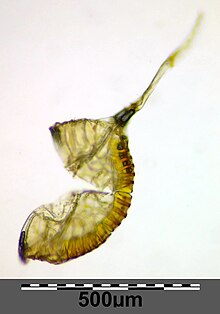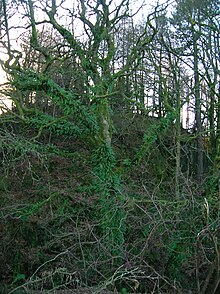
Pleopeltis polypodioides, also known as the resurrection fern, is a species of creeping, coarse-textured fern native to the Americas and Africa.

Nephrolepis exaltata, known as the sword fern or Boston fern, is a species of fern in the family Lomariopsidaceae. It is native to the Americas. This evergreen plant can reach as high as 40–90 centimetres (16–35 in), and in extreme cases up to 1.5 metres. It is also known as the Boston sword fern, wild Boston fern, Boston Blue Bell Fern, tuber ladder fern, or fishbone fern.

Onoclea sensibilis, the sensitive fern, also known as the bead fern, is a coarse-textured, medium to large-sized deciduous perennial fern. The name comes from its sensitivity to frost, the fronds dying quickly when first touched by it. It is sometimes treated as the only species in Onoclea, but some authors do not consider the genus monotypic.

Pteridium aquilinum, commonly called bracken, brake, common bracken, and also known as eagle fern, is a species of fern occurring in temperate and subtropical regions in both hemispheres. Originally native to Eurasia and North America, the extreme lightness of its spores has led to it achieving a cosmopolitan distribution.

Phlebodium aureum is an epiphytic fern native to tropical and subtropical regions of the Americas.

Aglaomorpha fortunei, commonly known as gu-sui-bu, is a species of basket fern of the family Polypodiaceae. The plant is native to Eastern Asia, including eastern China.

Psilotum nudum, the whisk fern, is a fernlike plant. Like the other species in the order Psilotales, it lacks roots.

Annual Review of Plant Biology is a peer-reviewed scientific journal published by Annual Reviews. It was first published in 1950 as the Annual Review of Plant Physiology. Sabeeha Merchant has been the editor since 2005, making her the longest-serving editor in the journal's history after Winslow Briggs (1973–1993). As of 2023, Journal Citation Reports lists the journal's 2022 impact factor as 23.9, ranking it second of 238 journal titles in the category "Plant Sciences". As of 2023, it is being published as open access, under the Subscribe to Open model.

Polypodium glycyrrhiza, commonly known as licorice fern, many-footed fern, and sweet root, is a summer deciduous fern native to western North America, where it is found in shaded, damp locations.

Osladine is a high-intensity sweetener isolated from the rhizome of Polypodium vulgare. It is a saponin, sapogenin steroid glycoside, 500 times sweeter than sucrose.

Polypodium virginianum, commonly known as rock polypody, rock cap fern, or common polypody, is a small evergreen species of fern native to the Eastern United States and Canada. It generally grows on rocks and occasionally on tree roots in nature.

Polypodium appalachianum is a fern species native to eastern North America. Sometimes called the Appalachian polypody or Appalachian rockcap fern, it is very similar in appearance to Polypodium virginianum. For years, P. virginianum—long considered a variety of the British Polypodium vulgare—was recognized as having cryptic races, with diploid, triploid, and tetraploid representatives. Since the triploid specimens bore abortive spores, it was apparently the hybrid between the diploid and tetraploid groups. In 1991, it was resolved that the type of P. virginianum was the tetraploid series, and that it is an allotetraploid species of hybrid origin, with the diploid species as one parent. The diploid species was then named P. appalachianum. The other parent of P. virginianum was found to be Polypodium sibiricum. The tetraploid of hybrid derivation tolerates warmer climates than either parent.

Angiopteris evecta, commonly known as the king fern, giant fern, elephant fern, oriental vessel fern, Madagascar tree fern, or mule's Foot fern, is a very large rainforest fern in the family Marattiaceae native to most parts of Southeast Asia and Oceania. It has a history dating back about 300 million years, and is believed to have the longest fronds of any fern in the world.
Stomatal conductance, usually measured in mmol m−2 s−1 by a porometer, estimates the rate of gas exchange and transpiration through the leaf stomata as determined by the degree of stomatal aperture.

Aglaomorpha is a genus of ferns in the subfamily Drynarioideae of the family Polypodiaceae. The Pteridophyte Phylogeny Group classification of 2016 uses this genus name, while other sources use Drynaria to include Aglaomorpha. Species are commonly known as basket ferns. As circumscribed in PPG I, the genus contains around 50 species.
Common polypody is a common name for several ferns in the genus Polypodium and may refer to:

Winslow Russell Briggs was an American plant biologist who introduced techniques from molecular biology to the field of plant biology. Briggs was an international leader in molecular biological research on plant sensing, in particular how plants respond to light for growth and development and the understanding of both red and blue-light photoreceptor systems in plants. His work has made substantial contributions to plant science, agriculture and ecology.
Lawrence Rogers Blinks was an American biologist with research interests in photosynthesis and electrophysiology. He served as the editor of the Annual Review of Plant Physiology for 1956.

Dipteris is a genus of about seven species of ferns, native to tropical regions across the world, particularly Asia, with a species in northeastern Queensland in Australia. It is one of two genera in the family Dipteridaceae.

Polypodium is a genus of ferns in the family Polypodiaceae, subfamily Polypodioideae, according to the Pteridophyte Phylogeny Group classification of 2016 (PPG I). The genus is widely distributed throughout the world, with the highest species diversity in the tropics. The name is derived from Ancient Greek poly (πολύ) "many" + podion (πόδιον) "little foot", on account of the foot-like appearance of the rhizome and its branches. They are commonly called polypodies or rockcap ferns, but for many species unique vernacular names exist.






















